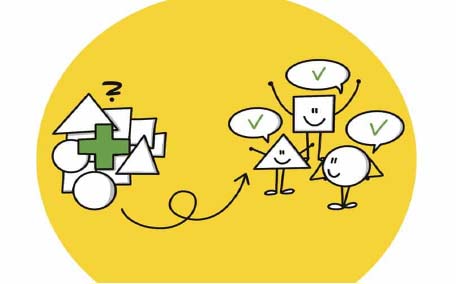Visual Metaphors for Complex Diagnoses

Are you part of the new generation of hospital staff who see it as their task to truly involve and inform the patient?
Do you want to be able to visually support explanations about diseases? Fortunately, you’re not alone!
My father belonged to the stereotype of the old-fashioned doctor—grumpy, mumbling, owl-like, with a deep voice and unreadable handwriting. For him, there was no need to explain disease processes or involve you in treatment plans. You simply did what he instructed. Fortunately, those stereotypes are a thing of the past! The new stereotype is more in line with accessible doctors, almost friendly in nature, wearing colorful clogs and scooting through the hallways. Whether that’s exaggerated or not, there is much more emphasis on the communication skills of doctors and other hospital staff. There is much more value placed on participation, understanding, interaction, and collaboration between doctor and patient. However, research in the Netherlands shows that many patients do not have the ability to understand what doctors are saying. Do you also experience how challenging it can be to explain diagnoses that are often very complex?
In my opinion, it is logical that the anxiety people experience during conversations with doctors prevents them from processing and understanding a lot of information, which means it doesn’t stick well. Visualizing information can help organize and clarify it, allowing for better filtering and comprehension. An image provides a framework for structuring the conversation, making it easier to follow. Using metaphors makes complex information much more accessible because it links what is new and loaded (such as information about medical treatment) to what is familiar and lighthearted (like a metaphor of a vegetable garden). The fact that a metaphor is better understood and remembered than jargon and purely medical information also empowers the patient. They now have the words to explain to others (and to themselves) what is happening and what will happen to them. This gives them the tools to ask questions and a certain level of control and empowerment, which undoubtedly has a positive effect on their well-being!
Do you want to remove jargon from your explanations of complex medical matters and support them with visually created metaphors? A lot is available already! Pediatrician Charlie Obihara, who has been associated with the Elizabeth-TweeSteden Hospital (ETZ) in Tilburg, the Netherlands for over fifteen years, developed metaphors to help children better understand their diseases. With young doctors and a group of illustrators, he worked on visualizing the metaphors and developing a website. On the website www.medifoor.nl, approximately 50 visual mediphors have been collected, which can be used to support conversations between healthcare professionals and patients.
In a recent interview with Obihara in a Dutch newspaper, he said: “Patients often don’t understand what doctors are telling them because some diseases are simply too complex. How do you explain leukemia to a child? The metaphor of an overgrown vegetable garden makes the disease more comprehensible. When grass (the malignant cells) obstructs the vegetables (healthy cells), they can no longer grow. Weed killers are needed, a metaphor for chemotherapy. They also kill the good plants, but afterward, they have the chance to regrow.”

The mediphor for leukemia: an overgrown vegetable garden that needs to be sprayed.
Image from medifoor.nl.
At the moment, Medifoor contains fifty illustrations. The goal is to eventually have hundreds. If you already have beautiful metaphors, you can submit them via the website www.mediform.nl to make them accessible to a large group and make them even more valuable!
Business Drawing with Draw Your Message
Draw your message helps you to increase the impact of your communication. Simple, expressive drawings visually convey what you communicate. Many people refer to this as ‘business drawing’ or ‘visual communication’. Draw your message teaches you how to say more than a thousand words with a single picture. We do this by providing training and workshops in business drawing. If you prefer a book in your hands, check out our book Conversations visualized.
